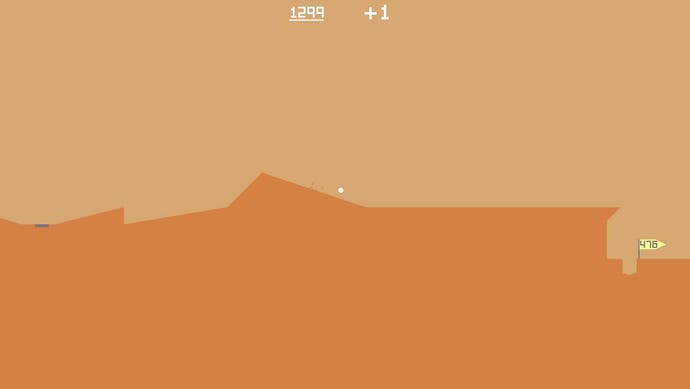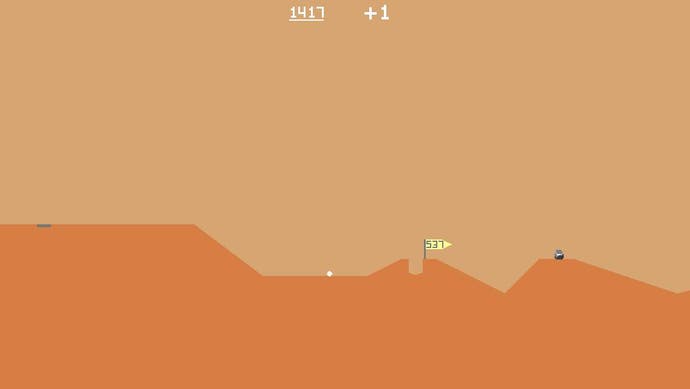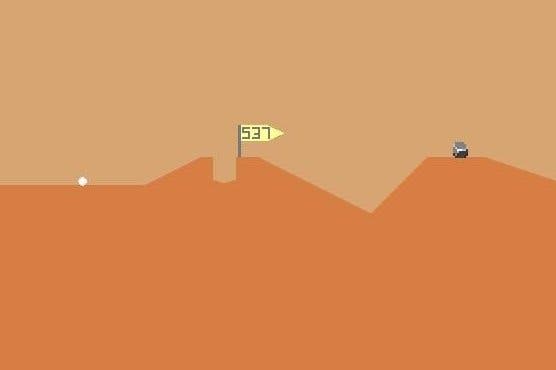Desert Golfing review
Greater than the sum of its pars.
Mobile games! Remember them? They used to be the future of all this, but then a few things happened. First of all it turned out that the autorunner was not the start of a wave of new and exciting genres but pretty much the end of them. Then the businessmen and cloners moved in and turned pretty much everything else into exploitative crap. There are still a few people out there doing good mobile work, but usually more for the love than the sustainable income.
There are occasional exceptions, though - really good mobile games that achieve great success despite the forces aligned against them - and Desert Golfing is a delicious example.
At a mechanical level, Desert Golfing is near enough to your average sports game, or at least a parlour game equivalent. You fire the ball by touching the screen and dragging your finger back as though you're drawing an arrow in a bow, intuitively assigning speed and direction to your shot and then watching as it is fired with satisfying weight and inertia toward the pointy dunes that lie ahead. When it strikes land or slows to a roll, it moves exactly the way you'd expect a golf ball to bounce or trickle along well-tended sand.
But it's obvious pretty quickly that Desert Golfing has little in common with games like PGA Tour (or "Tiger Woods" in old money). The courses, which have been procedurally generated, would certainly spoil a good walk, as the saying goes, but in a manner more akin to playing up a mountainside. Each is set on a single screen and often consists of various sharp climbs and descents that will catch your ball if it's under-hit or if it has too much momentum, while ending in a crevice usually obscures your path to the hole as well, necessitating a bit of playing this way before you can go that way.

A more dramatic departure, though, is the fact you cannot go back and start your round again. There is no menu and there's no reset button - the only way to return your ball to the tee is to fire it off one side of the screen, which adds another shot to your ever-present score. If you end up taking 50 strokes on one particularly fiendish hole, the only way to live them down will be to perform so well on the next few hundred holes that the overall average starts to seem less embarrassing. Short of deleting the game and reinstalling it, you have to live with your successes and your failures forever.
The game's creator, Justin Smith, has said that he was inspired by the desert in Journey and his desire to whack a ball into it, but in many ways Desert Golfing reminds me of Dark Souls: the brilliantly realised central mechanic that remains satisfying almost in perpetuity, the permanence of your actions, the fascination it all engenders. Perhaps Desert Golfing will also influence a lot of more mainstream designers - imagine a FIFA game where players automatically age at a set rate, whether you're playing the game or not, so that in 12 months' time when they're all knackered, you're forced to upgrade. (Actually, that's a bit close to the bone - how about a FIFA game with an occasional cactus instead?)
There are thousands of holes in Desert Golfing. I am ashamed to say I've only seen 800 of them, but apparently things get a bit harder after 2000 and the game may run out of ideas a bit when you get into the 3000s. And despite their procedural generation, the courses are the same for everyone, leading to veneration and deconstruction of individual challenges in ways you don't get with individually tailored experiences. All the same, Smith has said he "would have put more thought into the later holes if I had known people would be so devoted to it".

It's a shame Desert Golfing lacks a grand finale, but in a way it's a compliment to everything else in the game that it feels like it deserves that mild criticism. For something so outwardly throwaway to inspire so much interest and analysis (to inspire conspiracy theories, according to a Gamasutra interview, about whether the evolving RGB values signify the difficulty curve) is a great credit to the artistic instincts of its creator, who can be forgiven for having the modesty not to anticipate its popularity.
Above all though, I like the fact that it's kind of an art game take on stupid coconut-shy mobile sports rubbish while also being an extremely good example of the latter. It's the sort of game you could write a paper about but you will also see randoms playing and enjoying on the train. And apart from the superb control and physics, that comes down to something that mobile games originally gave us that has rather fallen by the wayside: instant-on accessibility. As Smith said to Gamasutra: "I'm actually really happy about the reaction to the no menu, no restarts thing. I wasn't sure it was going to fly, but most people seem to dig it. It also means that you can make progress in the game if you have literally 10 seconds to spare. It feels really good to have a game with such an affinity to its platform."
Apart from anything else, then, Desert Golfing is a reminder that our old friends the mobile games did have plenty to teach us - and can again.









